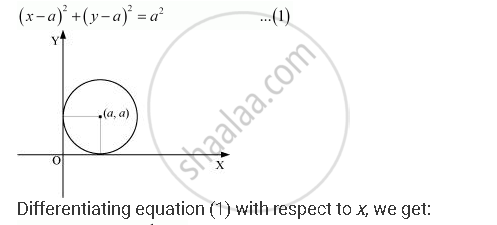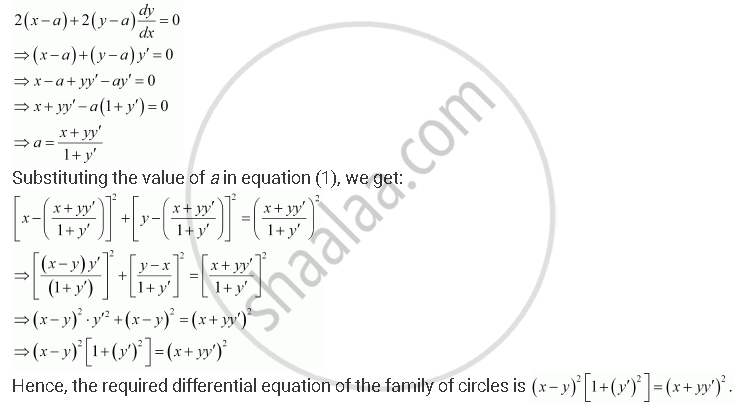Advertisements
Advertisements
Question
Form the differential equation of the family of circles in the first quadrant which touch the coordinate axes.
Solution
The equation of a circle in the first quadrant with centre (a, a) and radius (a) which touches the coordinate axes is:


APPEARS IN
RELATED QUESTIONS
Form the differential equation of the family of parabolas having vertex at origin and axis along positive y-axis.
Form the differential equation of the family of ellipses having foci on y-axis and centre at origin.
Show that the family of curves for which `dy/dx = (x^2+y^2)/(2x^2)` is given by x2 - y2 = cx
Form the differential equation from the following primitive where constants are arbitrary:
y = cx + 2c2 + c3
Find the differential equation of the family of curves y = Ae2x + Be−2x, where A and B are arbitrary constants.
Form the differential equation corresponding to y2 − 2ay + x2 = a2 by eliminating a.
Form the differential equation corresponding to (x − a)2 + (y − b)2 = r2 by eliminating a and b.
Form the differential equation of the family of curves represented by the equation (a being the parameter):
(2x + a)2 + y2 = a2
Form the differential equation of the family of curves represented by the equation (a being the parameter):
(x − a)2 + 2y2 = a2
Represent the following families of curves by forming the corresponding differential equations (a, b being parameters):
x2 + y2 = a2
Represent the following families of curves by forming the corresponding differential equations (a, b being parameters):
x2 − y2 = a2
Represent the following families of curves by forming the corresponding differential equations (a, b being parameters):
x2 + (y − b)2 = 1
Represent the following families of curves by forming the corresponding differential equations (a, b being parameters):
(x − a)2 − y2 = 1
Represent the following families of curves by forming the corresponding differential equations (a, b being parameters):
y = ax3
Represent the following families of curves by forming the corresponding differential equations (a, b being parameters):
y = eax
Show that y = bex + ce2x is a solution of the differential equation, \[\frac{d^2 y}{d x^2} - 3\frac{dy}{dx} + 2y = 0\]
Find one-parameter families of solution curves of the following differential equation:-
\[\frac{dy}{dx} + 3y = e^{mx}\], m is a given real number.
Find one-parameter families of solution curves of the following differential equation:-
\[\frac{dy}{dx} - y = \cos 2x\]
Find one-parameter families of solution curves of the following differential equation:-
\[x\frac{dy}{dx} - y = \left( x + 1 \right) e^{- x}\]
Find one-parameter families of solution curves of the following differential equation:-
\[x\frac{dy}{dx} + y = x^4\]
Find one-parameter families of solution curves of the following differential equation:-
\[\left( x \log x \right)\frac{dy}{dx} + y = \log x\]
Find one-parameter families of solution curves of the following differential equation:-
\[\frac{dy}{dx} \cos^2 x = \tan x - y\]
Find one-parameter families of solution curves of the following differential equation:-
\[x \log x\frac{dy}{dx} + y = 2 \log x\]
Form the differential equation of the family of ellipses having foci on y-axis and centre at the origin.
Form the differential equation representing the family of curves `y2 = m(a2 - x2) by eliminating the arbitrary constants 'm' and 'a'.
Find the differential equation of the family of curves y = Ae2x + B.e–2x.
Find the equation of a curve passing through the point (1, 1) if the perpendicular distance of the origin from the normal at any point P(x, y) of the curve is equal to the distance of P from the x-axis.
Find the equation of a curve passing through (2, 1) if the slope of the tangent to the curve at any point (x, y) is `(x^2 + y^2)/(2xy)`.
Find the equation of the curve through the point (1, 0) if the slope of the tangent to the curve at any point (x, y) is `(y - 1)/(x^2 + x)`
Family y = Ax + A3 of curves will correspond to a differential equation of order ______.
Form the differential equation of family of circles having centre on y-axis and raduis 3 units
Form the differential equation of the family of hyperbola having foci on x-axis and centre at origin.
